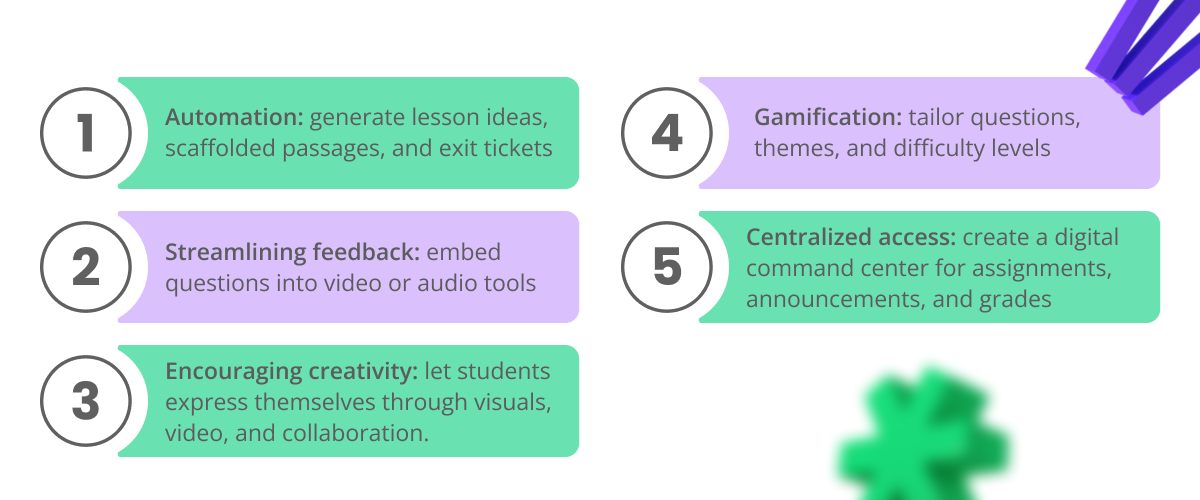Teaching with EdTech: 5 Practical Ways to Simplify Instruction



By Melinda Medina
I remember teaching classes with only chalkboards and chalk—no smartboards, no access to laptops, just dust-covered hands and creativity to fill the room. Those early teaching days taught me that innovation during that time did not depend on technology; it begins with imagination. Once our school community began receiving funding for technology and I finally had a smartboard and laptops in my classroom, integrating them into my lessons often felt more like an extra task than a tool for support.
Between lesson planning, grading, and keeping up with the latest digital trends, I often wondered, is this actually helping me teach, or just adding to my workload?
Over time, though, I discovered that the right combination of tools can make instruction lighter, more engaging, and far more efficient. If as an educator, you’ve ever ended a school day with 73 open tabs, a half-finished lesson plan, and a mental note to “catch up on grading this weekend,” you’re not alone. Teaching is a labor of love, but it can also feel like a marathon run at sprint speed. That’s where EdTech, when used intentionally, can help simplify what already exists.
RECOMMENDED READ: A Survival Guide for Educators: 12 Classroom Realities You Discover the Hard Way
Here we are now, in the midst of the Fourth Industrial Revolution, a period defined by rapid digitization and technological advancement, education continues to evolve in extraordinary ways. The tools once considered luxuries, like interactive smartboards, adaptive learning platforms, and AI-assisted planning tools, have become essential supports that make instruction more efficient, engaging, and accessible. Technology no longer simply enhances teaching; it transforms it, allowing educators to differentiate lessons with ease, provide instant feedback, and ensure that students with diverse learning needs can access content in ways that work best for them. What once felt like an extra task has become an integral part of creating equitable, personalized, and dynamic learning experiences for every student.
How EdTech Simplified My Classroom Without Losing the Human Touch
Here are five practical ways I’ve learned to simplify teaching with EdTech without losing the human connection that makes our classrooms come alive.

1. Automate the Small Stuff: One of the biggest time-savers for me has been embracing automation. Tools like MagicSchool AI, Diffit, and Curipod generate lesson ideas, scaffolded passages, and exit tickets in minutes. These tools don’t replace teachers, they enhance our capacity, freeing time for what matters most: connecting with students and adjusting lessons in real time.
2. Gamify Learning: Gamification transforms review into excitement. Platforms like Kahoot, Blooket, and Wayground are highly customizable, allowing educators to tailor questions, themes, and difficulty levels to suit all grade levels and meet diverse learning needs, ensuring every learner can participate meaningfully. I’ve seen quiet students become team captains in Kahoot challenges, discovering confidence through play. Engagement rises, and so does joy.
3. Streamline Feedback: Providing feedback used to mean lugging home stacks of papers. Now, tools like Google Classroom, Edpuzzle, and Mote allow me to give timely, personalized feedback. With Edpuzzle, I can embed questions into videos and track comprehension; audio tools like Mote let me connect personally through voice.
4. Centralize and Simplify Access: Having everything in one place reduces frustration for both teachers and students. Platforms like Google Classroom, Canvas, and Schoology act as digital command centers for assignments, announcements, and grades. For students with learning differences, consistency reduces anxiety and builds independence.
5. Encourage Student Creativity: The best part of EdTech is how it amplifies student voice. Tools like Canva for Education, and Padlet let students express themselves through visuals, video, and collaboration.
Technology should never replace good teaching, it should amplify it. When used intentionally, it simplifies our workflow, increases engagement, and creates space for authentic human connection.
Systems that Simplify the Work

If the first part of my journey was about rediscovering the why behind EdTech, this part focuses on the how. Once I stopped chasing every new app and started building consistent systems, technology became an ally rather than a burden.
Here are five practical systems that make teaching more efficient and sustainable.
1. Automate Formative Assessment and Grading: Switching from paper-based quizzes to auto-graded digital assessments has been my single greatest time-saver. Platforms like Google Forms, Socrative, Formative provide instant data, helping me target support right away. Instead of collecting exit slips, I use one-question digital polls or LMS submissions to track mastery and group students efficiently.
2. Consolidate Your Digital “Home Base”: App fatigue is real. I solved it by designating one consistent space—Google Classrooms—as our single source of truth. All assignments, announcements, and links live there. Using single sign-on (SSO) ensures students access everything with one login, saving valuable class time.
3. Front-Load Content with Video and Multimedia: Recording short instructional videos with tools like Loom or Screencastify lets students learn at their own pace. This flipped approach transforms class time into a workshop for practice, collaboration, and support, making my presence more meaningful and my teaching more responsive.
4. Personalize Learning with Adaptive Platforms: Differentiation doesn’t have to be overwhelming. Adaptive tools like Khan Academy and IXL automatically adjust practice based on student performance, providing individualized pathways without endless prep. I also use digital choice boards that let students demonstrate mastery through podcasts, presentations, or essays which offer choice without chaos.
5. Streamline Communication with Families: Instead of juggling paper notes and scattered emails, I use communication apps like Remind or ClassDojo to stay connected with families. Quick messages and automated grade summaries give parents real-time insight into student progress, fostering transparency and partnership.
Reclaiming Joy Through Technology
Whether through storytelling or systems, EdTech has transformed how I teach and how my students learn. The key isn’t using every tool, it’s using the right ones with purpose. I’ll never forget when a student who rarely spoke in class created a Flip video analyzing Still I Rise by Maya Angelou. Her confidence and insight reminded me why thoughtful tech integration matters.
Technology should never replace good teaching but when we use EdTech intentionally, it lightens our workload, strengthens engagement, and creates space for authentic human connection. As an educator, teaching with EdTech is about reclaiming our time, re-energizing our instruction, and giving students new pathways to be seen, heard, and celebrated.
By simplifying the repetitive and administrative parts of teaching, I’ve rediscovered the joy of focused, high-quality instruction and the deeper purpose behind why I teach in the first place. When grounded in humanity and equity, technology doesn’t just simplify instruction it amplifies impact.

Melinda is an aspiring leader, consultant, special educator, published author, and advocate for equitable education. She holds a Master of Science in Teaching and a Master of Science in Educational Leadership, and has dedicated her career to supporting neurodiverse students and breaking generational cycles through education.



